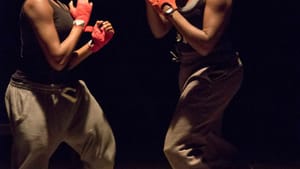Stay in the Loop
BSR publishes on a weekly schedule, with an email newsletter every Wednesday and Thursday morning. There’s no paywall, and subscribing is always free.
Same-sex Shakespeare
All-female 'Henry IV' directed by Phyllida Lloyd

What first appeared as a novelty is now becoming a norm, it seems. Same-sex companies performing Shakespeare are close to being an annual staple in the theater here these days.
Declan Donnellan’s UK-based Cheek by Jowl Company has been experimenting with all-male Shakespeare on and off for decades, but the trend arrived full-force on our shores in 2013 with Mark Rylance’s all-male company, which brought a dazzling double-bill of Twelfth Night and Richard III from London’s Globe to Broadway. In the same year, Phyllida Lloyd brought her all-female Julius Caesar from London’s Donmar Warehouse to St. Ann’s Warehouse in Brooklyn.
Lloyd is back this fall with the same company to give us an all-female Henry IV in St. Ann’s newly renovated space. As much as I admire the company’s skill and spirit, both in their previous production and this one, I nevertheless find myself wondering why they chose to repeat the casting conceit with this particular play.
Commenting on gender
At first, same-sex casting caused a sensation. With Rylance’s all-male double bill, audiences and critics alike were fascinated by the agility with which these virtuosic actors performed both male and female roles. Rylance dazzled us with his transformation from the ruthless Richard in Shakespeare’s tragedy to the vivacious Viola in his comedy.
His stellar company gave historical context to the casting conceit, by changing from their street clothes into 17th-century Elizabethan costumes (male and female) onstage in front of a rapt audience, a half hour before curtain. In that way, they reminded us of the historical fact that in Shakespeare’s time, the plays were always performed with all-male casts.
Lloyd’s casting of an all-female Julius Caesar was even more daring, since it didn’t have the same historical precedent. Moreover, Julius Caesar is a play about power, conspiracy, and violence, with all male characters (save one role). So it’s to the company’s credit that they pulled off this tour de force.
Lloyd set her Julius Caesar in a woman’s house of detention, where female prisoners are putting on the play. It was an effective metaphor, contrasting the powerlessness of the prisoners with the power of Shakespeare’s political figures. Moreover, it made a bold political statement about contemporary theater — a woman’s troupe dared, successfully, to claim these male roles for themselves.
Women playing fathers and sons
For Henry IV (presented as a conflation of Parts I and II), Lloyd has chosen to set the play again in a prison context, but the result is less effective. Henry IV is a play about fathers and sons, coming of age, ascension to the throne, and responsibility, so the prison frame makes less contextual sense. Moreover, the sons aren’t particularly likeable. Henry’s son Hal is an irresponsible profligate, who hangs out with the degenerate Falstaff and snorts cocaine (in this production). Northumberland’s son Hotspur is a hothead who is spoiling for a fight.
Still, it’s great fun to see these splendid actresses assume macho roles and play them with swagger and ease. Clare Dunne, with her Yorkshire accent, is a particularly rough and dissolute Hal, and Jade Anouka, as a muscular Hotspur, treats us to some pretty impressive pre-battle calisthenics. Sophie Stanton plays the legendary, larger-than-life Falstaff with relish and wit. So yes, they’ve made their point that the girls can do as well — if not better — than the boys, but what new insights do we gain into the play itself? And why is it set in a prison?
A meta-theatrical experience
On the other hand, I can’t deny that the framing device is effective. You watch these scraggly, pathetic-looking female prisoners in gray sweats led onto the stage floor in chain-gang fashion (the theatre has been transformed into the basketball court of the prison, with spectators on all four sides). Then you witness them morphing masterfully into their classical roles without costume changes. Occasionally, the prisoners-as-actors engage in scuffles, and the scene is stopped by big, burly guards. So you’re always aware that you’re watching a play within a play, which is a stimulating meta-theatrical experience.
 “Uneasy lies the head that wears the crown,” says Henry (Harriet Walter). The same can be said about playing a Shakespearean role. To deliver that gorgeous poetry and the essential humanity of the characters is a great challenge. In the end, as long as these actresses can deliver (and they do, impressively), one can hardly begrudge them the chance to play male parts. Nor should Maxine Peake and Zainab Jah be discouraged from claiming the role of Hamlet for their own, as both actresses did earlier this year at the Royal Manchester Exchange Theatre in England and the Wilma Theatre in Philadelphia, respectively.
“Uneasy lies the head that wears the crown,” says Henry (Harriet Walter). The same can be said about playing a Shakespearean role. To deliver that gorgeous poetry and the essential humanity of the characters is a great challenge. In the end, as long as these actresses can deliver (and they do, impressively), one can hardly begrudge them the chance to play male parts. Nor should Maxine Peake and Zainab Jah be discouraged from claiming the role of Hamlet for their own, as both actresses did earlier this year at the Royal Manchester Exchange Theatre in England and the Wilma Theatre in Philadelphia, respectively.
After all, this daring, invigorating new trend means more role opportunities for women in the theatre today, and that’s a great thing.
What, When, Where
Henry IV, by William Shakespeare. Phyllida Lloyd directed. Through December 13 at St. Ann’s Warehouse, 45 Water Street, Brooklyn. stannswarehouse.org
Sign up for our newsletter
All of the week's new articles, all in one place. Sign up for the free weekly BSR newsletters, and don't miss a conversation.